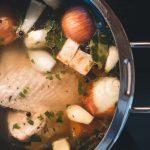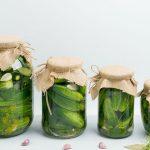When it comes to Japanese cuisine, most people think of sushi, ramen, and tempura. But there’s one ingredient that often goes overlooked, and that’s kanpyo.
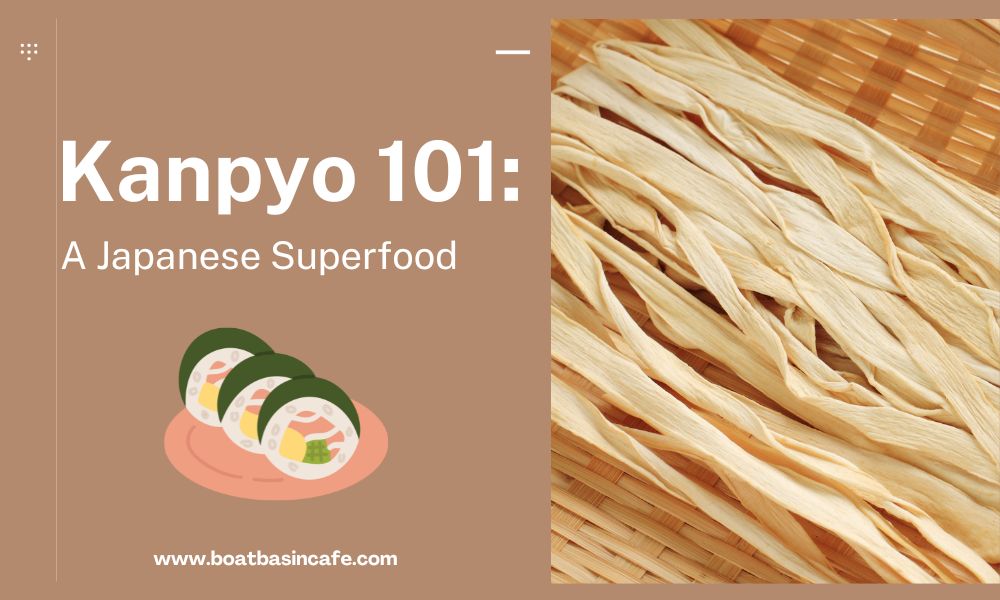
This dried gourd strip may not be as flashy as its more popular counterparts, but it packs a punch of flavor, savory taste, and texture that’s sure to elevate any dish.
This blog post will provide a comprehensive guide for beginners on how to prepare and cook with kanpyo.
We will cover everything from the basics of what kanpyo is and its origin, to tips on rehydration and preparation, and even provide some delicious recipes to try out.
So, let’s get started and learn all about this versatile ingredient!
A Traditional Japanese Food: What Is Kanpyo Made of?
All right, let’s start with the basics.
Kanpyo (or kampyō) is made of the calabash gourd (Cucurbitaceae family) that is dried, sliced into thin strips, and then dried again. It is a traditional and common ingredient in Japanese cooking.
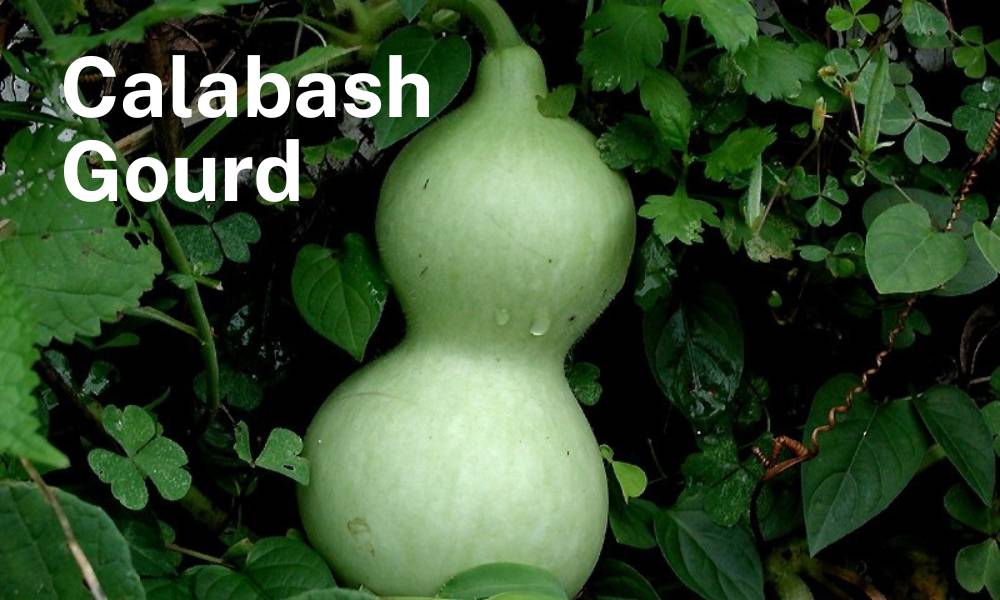
It looks like cream-colored ribbons. It’s like the gourd version of beef jerky, but way more versatile and delicious with a savory flavor.
It’s also a great source of dietary fiber, so you can feel good about incorporating it into your meals.
How It’s Made?
Kanpyo is made from a type of gourd called “Fukube” which is harvested between the end of June and the end of August. These gourds can reach up to 35-40 cm tall and weigh between 7-8 kg.
Once harvested, the white flesh of the gourd is cut into thin strips, like peeling the skin, and then dried in the sun or by hot air to create the dried gourd shavings or dried kanpyo strips.
How Does It Look?
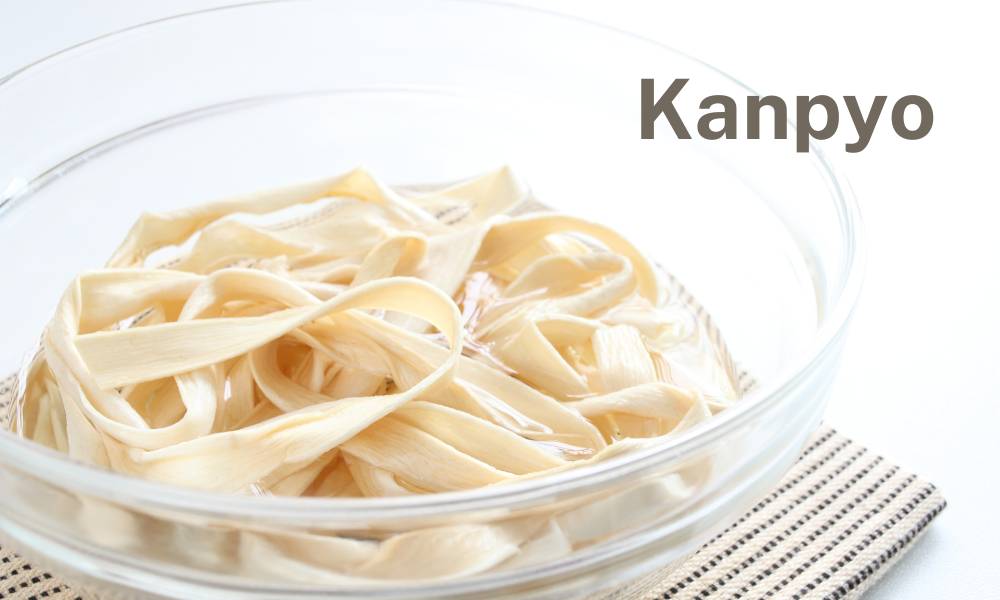
Kanpyo has a unique appearance, with its dried strips being light brown in color and having a wrinkled texture.
Kanpyo available in the US is sometimes chemically bleached to a very white color, but in Japanese cooking, it is mostly dried naturally.
Some preservatives like Sulfur dioxide are used but not in a concentration exceeding 5.0 g per 1 kg of dry matter.
Origin of Kanpyo: Dried Gourd
Kanpyo is a dried version of shavings from a calabash gourd. Dried kanpyo is produced in large quantities, with over 200 tons produced per year.
Most of the gourd used in Japan (approximately 90%) is grown in Tochigi prefecture, located in the north of Tokyo.
While the gourd plant is native to tropical regions of Africa and Asia, Japan is the only country where the dried form of it, kanpyo, has been eaten since ancient times during the Edo period (1603-1867).
What Does Kampyo Taste Like?
Kampyo, or kanpyo, has a mild and sweet taste with a chewy texture. It is often described as having a subtle vegetal flavor and a slight hint of sweetness.
The flavor and texture can vary depending on how it is prepared and the brand of kanpyo used. Its main attraction is its spongy and slightly chewy texture that adds a unique contrast when included in sushi rolls or soups.
Some chefs use seasoning such as soy sauce, sugar, or mirin to mask Kanpyo’s natural flavor.
Where to Buy Kampyo?
Kampyo can be found in most Asian markets or specialty stores in the US that sell Asian ingredients. Some popular grocery stores such as Whole Foods, Trader Joe’s, and Safeway also carry it.
It is also possible to purchase it online from retailers or websites that specialize in Japanese or Asian ingredients.
Buying Online
Kampyo, when dried, can last for around one year. It may change in color slightly over time, but it will still be safe to consume.
After rehydrating, it can be stored in the refrigerator for a week. it will last for up to 6 months in the freezer. However, it is recommended to only rehydrate the amount that will be used immediately.
This means that it’s perfectly fine to buy kampyo online and have it delivered to your home. Small packages of kampyo can be found on Amazon for a reasonable price.
If you ask my suggestion, the Kampyo from the Shirakiku brand is pretty good with lots of positive ratings. You can use it for different types of sushi or just eat!
Preparing Kanpyo

It’s important to note that before kanpyo can be used in cooking, it must first be rehydrated.
The process is simple, all you need to do is soak the dried strips in water for a few hours, and voila! Use two cups of water for every half cup of kanpyo.
But, before you go ahead and dump it into boiling water, let me remind you that the water should be room temperature or slightly warm.
Hot water = tough strips and nobody wants that.
The rehydration time will vary depending on the thickness of the strips, with thicker strips taking longer to soften.
It’s also important to note that different brands of kanpyo may have varying levels of dryness, which can affect the rehydration process. It’s best to follow the package instructions, but also be prepared to experiment a bit.
A good rule of thumb is to soak it for at least 4 hours, or overnight for best results. The extra water soaked in this process needs to be squeezed out before putting it on your recipe.
Watch this video from Sushi Kimura Singapore for a visual demonstration to prepare kanpyo.
Dishes Featuring Kanpyō
Kanpyo is commonly used in sushi dishes such as futomaki, rolled sushi called kanpyo-maki, and as a topping on chirashi sushi.

It’s also used as a binding agent in dishes such as kombu rolls and mochi nunchaku (deep-fried tofu skins stuffed with mochi).
Incorporating Kanpyo into Recipes
After you’ve rehydrated your kanpyo, it’s time to put it to use.
The most classic way to enjoy kanpyo is in sushi rolls, where it’s often paired with umeboshi (pickled plums) and shiso leaves for a perfect balance of salty and sweet flavors.
But don’t stop there! Kanpyo is also great in soups, like the traditional Japanese dish “Miso Soup with Kanpyo.”
If you’re feeling adventurous, you can also try sautéing or frying it for a crispy texture that’s perfect for salads, sandwiches, and stir-fries. The possibilities are endless, really.
In fact, I’ve got a recipe for a simple kanpyo salad that will knock your socks off.

Kanpyo Salad Ingredients
- 1 cup rehydrated kanpyo
- 1/2 cup finely sliced cucumber
- 1/4 cup finely sliced onion
- 1 tablespoon rice vinegar
- 1 teaspoon sugar
- 1/4 teaspoon salt
Step-by-Step Guide for Preparing Kanpyo Salad
1. In a large bowl, combine the rehydrated kanpyo, cucumber, and onion.
2. In a small bowl, mix together the rice vinegar, sugar, and salt.
3. Pour the dressing over the kanpyo mixture and toss to combine.
4. Let the salad sit for at least 30 minutes to allow the flavors to meld together.
5. Serve chilled and enjoy!
Health Benefits of Kanpyo
Half a cup of Kampyo (27g serving) has 70 calories and is a good source of iron, zinc, and vitamin B5.
The carbohydrates in Kanpyo are made up of dietary fiber, starch, and sugar. Dietary fiber content stands out at 9.8 grams per 100 grams of dried gourd.
It supports the intestinal function. It is also high in calcium, with more than dairy products and seafood, which is beneficial for bone development and preventing osteoporosis and irritation.
The calcium (280mg per 100 g serving) and magnesium (125mg) content in kanpyo are in a perfect balance of 2:1 for optimal absorption.
Additionally, Kanpyo is high in potassium, with 1582 mg per 100 g, which is 1.8 times more than parsley and 2.5 times more than avocado.
Potassium helps to reduce hypertension and swelling by discharging excess sodium in the urine.
Check out Nutrition Value and My Food Data for more information on the nutritional facts of Kanpyo.
Resources(Books, websites)
If you want to learn more about Kanpyo and Japanese cuisine, check the books below:
- “Japanese Cooking: A Simple Art” by Shizuo Tsuji
- “Japanese Soul Cooking: Ramen, Tonkatsu, Tempura, and More from the Streets and Kitchens of Tokyo and Beyond” by Tadashi Ono and Harris Salat
- “Japanese Food and Cooking” by Yasuko Fukuoka
- “Sado: The Way of Tea” by Soshitsu Sen
- “The Japanese Kitchen: 250 Recipes in a Traditional Spirit” by Hiroko Shimbo
Websites:
- Just One Cookbook (https://www.justonecookbook.com/)
- Japan Centre (https://www.japancentre.com/)
- Sado: The Way of Tea (https://www.sado.jp/)
- Tokyo Food Page (http://www.tokyofoodpage.com/)
FAQs
Can I use Kanpyo in non-Japanese dishes?
Absolutely! Kanpyo’s mild and slightly sweet flavor makes it a versatile ingredient that can be used in a variety of dishes. So, feel free to get creative and incorporate it into your favorite recipes.
Is kanpyo vegan?
Yes, kampyo is vegan. It is a popular addition to many vegan dishes. Kampyo is a great source of dietary fiber, and is also low in calories and fat, making it a healthy vegan option.
How do you make sushi rolls with kanpyo?
Start by soaking the dried kanpyo in water for at least 30 minutes, until it becomes soft and pliable. After that, drain the kanpyo and squeeze out any excess water. Place a sheet of sushi nori maki on a sushi mat, spread a thin layer of sushi rice over the nori, and put the soaked kanpyo on top of the rice. Roll the sushi with the help of the mat, using the border of rice at the top to seal the roll. Then slice the sushi roll into pieces and serve with soy sauce and wasabi, if desired.
